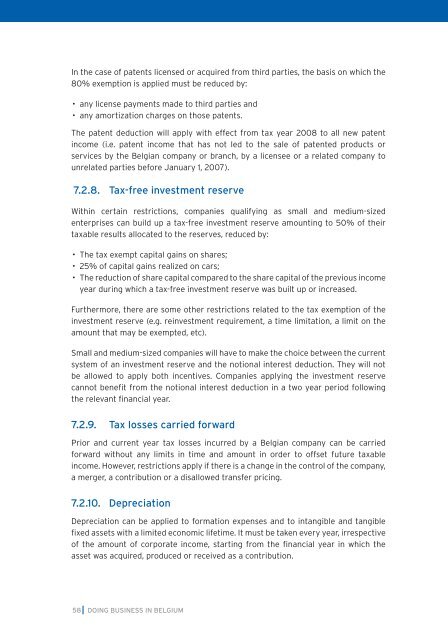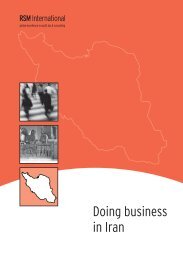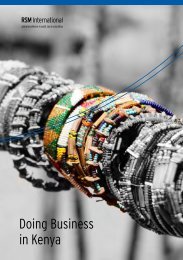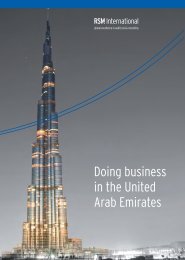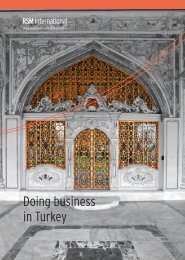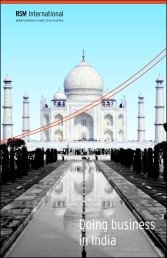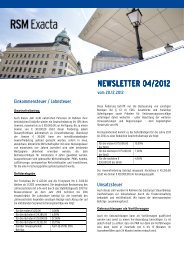Doing Business in Belgium - RSM International
Doing Business in Belgium - RSM International
Doing Business in Belgium - RSM International
Create successful ePaper yourself
Turn your PDF publications into a flip-book with our unique Google optimized e-Paper software.
In the case of patents licensed or acquired from third parties, the basis on which the<br />
80% exemption is applied must be reduced by:<br />
• any license payments made to third parties and<br />
• any amortization charges on those patents.<br />
The patent deduction will apply with effect from tax year 2008 to all new patent<br />
<strong>in</strong>come (i.e. patent <strong>in</strong>come that has not led to the sale of patented products or<br />
services by the Belgian company or branch, by a licensee or a related company to<br />
unrelated parties before January 1, 2007).<br />
7.2.8. Tax-free <strong>in</strong>vestment reserve<br />
With<strong>in</strong> certa<strong>in</strong> restrictions, companies qualify<strong>in</strong>g as small and medium-sized<br />
enterprises can build up a tax-free <strong>in</strong>vestment reserve amount<strong>in</strong>g to 50% of their<br />
taxable results allocated to the reserves, reduced by:<br />
• The tax exempt capital ga<strong>in</strong>s on shares;<br />
• 25% of capital ga<strong>in</strong>s realized on cars;<br />
• The reduction of share capital compared to the share capital of the previous <strong>in</strong>come<br />
year dur<strong>in</strong>g which a tax-free <strong>in</strong>vestment reserve was built up or <strong>in</strong>creased.<br />
Furthermore, there are some other restrictions related to the tax exemption of the<br />
<strong>in</strong>vestment reserve (e.g. re<strong>in</strong>vestment requirement, a time limitation, a limit on the<br />
amount that may be exempted, etc).<br />
Small and medium-sized companies will have to make the choice between the current<br />
system of an <strong>in</strong>vestment reserve and the notional <strong>in</strong>terest deduction. They will not<br />
be allowed to apply both <strong>in</strong>centives. Companies apply<strong>in</strong>g the <strong>in</strong>vestment reserve<br />
cannot benefit from the notional <strong>in</strong>terest deduction <strong>in</strong> a two year period follow<strong>in</strong>g<br />
the relevant f<strong>in</strong>ancial year.<br />
7.2.9. Tax losses carried forward<br />
Prior and current year tax losses <strong>in</strong>curred by a Belgian company can be carried<br />
forward without any limits <strong>in</strong> time and amount <strong>in</strong> order to offset future taxable<br />
<strong>in</strong>come. However, restrictions apply if there is a change <strong>in</strong> the control of the company,<br />
a merger, a contribution or a disallowed transfer pric<strong>in</strong>g.<br />
7.2.10. Depreciation<br />
Depreciation can be applied to formation expenses and to <strong>in</strong>tangible and tangible<br />
fixed assets with a limited economic lifetime. It must be taken every year, irrespective<br />
of the amount of corporate <strong>in</strong>come, start<strong>in</strong>g from the f<strong>in</strong>ancial year <strong>in</strong> which the<br />
asset was acquired, produced or received as a contribution.<br />
Depreciation is calculated on the basis of the acquisition value and the useful life of<br />
the asset. Two depreciation methods are applicable: a straight-l<strong>in</strong>e method (which<br />
is the most commonly used method) and a double decl<strong>in</strong><strong>in</strong>g-balance depreciation<br />
method, which is optional.<br />
Under the straight-l<strong>in</strong>e depreciation method, the asset is depreciated over its useful<br />
economic lifetime based on a fixed percentage of the acquisition value.<br />
The double decl<strong>in</strong><strong>in</strong>g balance method takes as a depreciation percentage the<br />
double of the straight-l<strong>in</strong>e depreciation percentage with a maximum of 40% of the<br />
acquisition value. Each subsequent year the depreciation is calculated on the value<br />
of the asset at the end of the previous f<strong>in</strong>ancial year. Once the annual depreciation is<br />
lower than it would be under the straight-l<strong>in</strong>e depreciation method, the taxpayer can<br />
switch back to the straight-l<strong>in</strong>e method.<br />
7.2.11. Rul<strong>in</strong>g regime<br />
All taxpayers may request from the tax authorities an “advance rul<strong>in</strong>g,” by which<br />
the Advance Rul<strong>in</strong>g Commission determ<strong>in</strong>es how the tax shall be applied to a<br />
particular situation or operation that has not yet taken any effect from a taxation<br />
po<strong>in</strong>t of view.<br />
The Advance Rul<strong>in</strong>g Commission must acknowledge the receipt of a request for an<br />
advance rul<strong>in</strong>g with<strong>in</strong> five work<strong>in</strong>g days. In pr<strong>in</strong>ciple, a first meet<strong>in</strong>g must be organized<br />
with<strong>in</strong> 15 work<strong>in</strong>g days of the receipt of the request for an advance rul<strong>in</strong>g. The law<br />
states that the decision regard<strong>in</strong>g the advance rul<strong>in</strong>g should be communicated to the<br />
taxpayer with<strong>in</strong> three months of the date of the fil<strong>in</strong>g of the rul<strong>in</strong>g request. However,<br />
the Advance Rul<strong>in</strong>g Commission and the taxpayer may mutually agree to modify<br />
this period. The three-month period is <strong>in</strong>dicative <strong>in</strong> the sense that no sanctions are<br />
provided for if the Advance Rul<strong>in</strong>g Commission does not meet this deadl<strong>in</strong>e.<br />
The Advance Rul<strong>in</strong>g Commission must notify the taxpayer regard<strong>in</strong>g its decision<br />
<strong>in</strong> respect of the advance rul<strong>in</strong>g. If the Advance Rul<strong>in</strong>g Commission cannot give<br />
a positive rul<strong>in</strong>g, the taxpayer is often <strong>in</strong>vited to withdraw the request to avoid a<br />
negative rul<strong>in</strong>g be<strong>in</strong>g given.<br />
The Tax Adm<strong>in</strong>istration is bound by the decision given regard<strong>in</strong>g an advance rul<strong>in</strong>g.<br />
However, a taxpayer is not bound by the rul<strong>in</strong>g and does not have to carry out the<br />
envisaged transaction or action. In pr<strong>in</strong>ciple, the rul<strong>in</strong>gs are valid for a period of five<br />
years, but can be renewed. If required, the period of the validity of the rul<strong>in</strong>g may be<br />
longer (e.g. a rul<strong>in</strong>g with respect to depreciation of a build<strong>in</strong>g).<br />
58<br />
DOING BUSINESS IN BELGIUM<br />
DOING BUSINESS IN BELGIUM<br />
59


